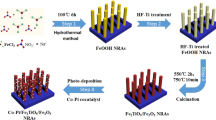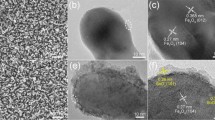Abstract
The hematite films prepared by electrodeposition (ED) and hydrothermal (HT) methods have similar nanorods morphology and the same length. However, the hematite prepared by HT method has higher photocurrent density and negative shift of onset potential. The samples are systematically characterized by scanning electron microscopy, UV–Vis spectra, X-ray diffractometry and photoelectrochemical measurements. The results reveal that the enhanced photoelectrochemical (PEC) performance of HT hematite is attributed to the superior surface charge injection efficiency, which is caused by a slower surface recombination rate rather than a more catalytically active hematite surface. And the slower surface recombination rate can be attributed to the absence of the slow surface states CSS2. This work provides an in-depth understanding of the reasons for the different PEC performance of hematite photoanodes fabricated by ED and HT methods, which is of certain significance in guiding the modification of hematite photoanodes prepared by the two typical routes in PEC water splitting system.









Similar content being viewed by others
References
Fujishima A, Honda K (1972) Electrochemical photolysis of water at a semiconductorelectrode. Nature 238:37–38
Daghrir R, Drogui P, Khakani MAE (2013) Photoelectrocatalytic oxidation of chlortetracycline using Ti/TiO2 photo-anode with simultaneous H2O2 production. Electrochim Acta 87:18–31
Li H, Zhou Q, Gao Y, Gui X, Yang L, Du M, Shi E, Shi J, Cao A, Fang Y (2015) Templated synthesis of TiO2 nanotube macrostructures and their photocatalytic properties. Nano Res 8:900–906
Wang T, Jin B, Jiao Z, Lu G, Ye J, Bi Y (2015) Electric field-directed growth and photoelectrochemical properties of cross-linked Au-ZnO hetero-nanowirearrays. Chem Commun 51:2103–2106
Kim JK, Bae S, Kim W, Jeong MJ, Lee SH, Lee CL, Choi WK, Hwang JY, Park JH, Son DI (2015) Nano carbon conformal coating strategy for enhanced photoelectrochemical responses and long-term stability of ZnO quantumdots. Nano Energy 13:258–266
Sivula K, Le Formal F, Grätzel M (2011) Solar water splitting: progress using hematite (α-Fe2O3) photoelectrodes. Chemsuschem 4:432–449
Kumar P, Sharma P, Shrivastav R, Dass S, Satsangi VR (2011) Electrodeposited zirconium-doped α-Fe2O3 thin film for photoelectrochemical water splitting. Int J Hydrogen Energy 36:2777–2784
Aleksić OS, Vasiljević ZŽ, Vujković M, Nikolić M, Labus N, Luković MD, Nikolić MV (2017) Structural and electronic properties of screen-printed Fe2O3/TiO2 thick films and their photoelectrochemical behavior. J Mater Sci 52:5938–5953. https://doi.org/10.1007/s10853-017-0830-2
Wang S, Chen H, Gao G, Butburee T, Lyu M, Thaweesak S, Yun JH, Du A, Liu G, Wang L (2016) Synergistic crystal facet engineering and structural control of WO3 films exhibiting unprecedented photoelectrochemical performance. Nano Energy 24:94–102
Jiang T, Xie T, Yang W, Chen L, Fan H, Wang D (2013) Photoelectrochemical and photovoltaic properties of p–n Cu2O homojunction films and their photocatalytic performance. J Phys Chem C 117:4619–4624
Wang S, Chen P, Yun JH, Hu Y, Wang L (2017) An electrochemically treated BiVO4 photoanode for efficient photoelectrochemical water splitting. Angew Chem Int Ed 129:8620–8624
Zhen C, Chen R, Wang L, Liu G, Cheng HM (2016) Tantalum (oxy) nitride based photoanodes for solar-driven water oxidation. J Mater Chem A 4:2783–2800
Ong WJ, Tan LL, Ng YH, Yong ST, Chai SP (2016) Graphitic carbon nitride (g-C3N4)-based photocatalysts for artificial photosynthesis and environmental remediation: are we a step closer to achievingsustainability? Chem Rev 116:7159–7329
Zhang H, Nai J, Yu L, Lou XW (2017) Metal-organic-framework-based materials as platforms for renewable energy and environmental applications. Joule 1:77–107
Kennedy JH, Frese KW (1978) Photooxidation of water at α-Fe2O3 electrodes. J Electrochem Soc 125:709–714
Itoh K, Bockris JM (1984) Stacked thin-film photoelectrode using iron oxide. J Appl Phys 56:874–876
Itoh K, Bockris JM (1984) Thin film photoelectrochemistry: iron oxide. J Electrochem Soc 131:1266–1271
Dare-Edwards MP, Goodenough JB, Hamnett A, Trevellick PR (1983) Electrochemistry and photoelectrochemistry of iron (III) oxide. J Chem Soc Faraday Trans 1 Phys Chem Condens Phases 79:2027–2041
Morin FJ (1951) Electrical properties of α-Fe2O3 and α-Fe2O3 containing titanium. Phys Rev 83:1005
Lindgren T, Wang H, Beermann N, Vayssieres L, Hagfeldt A, Lindquist SE (2002) Aqueous photoelectrochemistry of hematite nanorod array. Sol Energy Mater Sol Cells 71:231–243
Tilley SD, Cornuz M, Sivula K, Grätzel M (2010) Light-induced water splitting with hematite: improved nanostructure and iridium oxide catalysis. Angew Chem 122:6549–6552
Lin Y, Zhou S, Sheehan SW, Wang D (2011) Nanonet-based hematite heteronanostructures for efficient solar water splitting. J Am Chem Soc 133:2398–2401
Glasscock JA, Barnes PR, Plumb IC, Savvides N (2007) Enhancement of photoelectrochemical hydrogen production from hematite thin films by the introduction of Ti and Si. J Phys Chem C 111:16477–16488
Duret A, Grätzel M (2005) Visible light-induced water oxidation on mesoscopic α-Fe2O3 films made by ultrasonic spray pyrolysis. J Phys Chem B 109:17184–17191
Brillet J, Grätzel M, Sivula K (2010) Decoupling feature size and functionality in solution-processed, porous hematite electrodes for solar water splitting. Nano Lett 10:4155–4160
Sivula K, Zboril R, Le Formal F, Robert R, Weidenkaff A, Tucek J, Frydrych J, Grätzel M (2010) Photoelectrochemical water splitting with mesoporous hematite prepared by a solution-based colloidal approach. J Am Chem Soc 132:7436–7444
Shen S, Li M, Guo L, Jiang J, Mao SS (2014) Surface passivation of undoped hematite nanorod arrays via aqueous solution growth for improved photoelectrochemical water splitting. J Colloid Interface Sci 427:20–24
Li L, Liu C, Qiu Y, Mitsuzak N, Chen Z (2017) The influence of the hydrothermal temperature and time on morphology and photoelectrochemical response of α-Fe2O3 photoanode. J Alloy Compd 696:980–987
Mohapatra SK, John SE, Banerjee S, Misra M (2009) Water photooxidation by smooth and ultrathin α-Fe2O3 nanotube arrays. Chem Mater 21:3048–3055
Spray RL, Choi KS (2009) Photoactivity of transparent nanocrystalline Fe2O3 electrodes prepared via anodic electrodeposition. Chem Mater 21:3701–3709
Zhang P, Kleiman-Shwarsctein A, Hu YS, Lefton J, Sharma S, Forman AJ, McFarland E (2011) Oriented Ti doped hematite thin film as active photoanodes synthesized by facile APCVD. Energy Environ Sci 4:1020–1028
Jiao S, Xu L, Hu K, Li J, Gao S, Xu D (2009) Morphological control of α-FeOOH nanostructures by electrodeposition. J Phys Chem C 114:269–273
Lian J, Duan X, Ma J, Peng P, Kim T, Zheng W (2009) Hematite (α-Fe2O3) with various morphologies: ionic liquid-assisted synthesis, formation mechanism, and properties. ACS Nano 3:3749–3761
Xu Y, Schoonen MA (2000) The absolute energy positions of conduction and valence bands of selected semiconducting minerals. Am Miner 85:543–556
Le Formal F, Grätzel M, Sivula K (2010) Controlling photoactivity in ultrathin hematite films for solar water-splitting. Adv Funct Mater 20:1099–1107
Herrera FV, Grez P, Schrebler R, Ballesteros LA, Muñoz E, Córdova R, Dalchiele EA (2010) Preparation and photoelectrochemical characterization of porphyrin-sensitized α-Fe2O3 thin films. J Electrochem Soc 157:D302–D308
Dotan H, Sivula K, Grätzel M, Rothschild A, Warren SC (2011) Probing the photoelectrochemical properties of hematite (α-Fe2O3) electrodes using hydrogen peroxide as a hole scavenger. Energy Environ Sci 4:958–964
Bard AJ, Bocarsly AB, Fan FRF, Walton EG, Wrighton MS (1980) The concept of Fermi level pinning at semiconductor/liquid junctions, Consequences for energy conversion efficiency and selection of useful solution redox couples in solar devices. J Am Chem Soc 102:3671–3677
Uosaki K, Kita H (1983) Effects of the Helmholtz layer capacitance on the potential distribution at semiconductor/electrolyte interface and the linearity of the Mott–Schottky plot. J Electrochem Soc 130:895–897
Wijayantha KU, Saremi-Yarahmadi S, Peter LM (2011) Kinetics of oxygen evolution at α-Fe2O3 photoanodes: a study by photoelectrochemical impedance spectroscopy. Phys Chem Chem Phys 13:5264–5270
Zandi O, Schon AR, Hajibabaei H, Hamann TW (2016) Enhanced charge separation and collection in high-performance electrodeposited hematite films. Chem Mater 28:765–771
Bassi PS, Xianglin L, Fang Y, Loo JSC, Barber J, Wong LH (2016) Understanding charge transport in non-doped pristine and surface passivated hematite (Fe2O3) nanorods under front and backside illumination in the context of light induced water splitting. Phys Chem Chem Phys 18:30370–30378
Bertoluzzi L, Bisquert J (2012) Equivalent circuit of electrons and holes in thin semiconductor films for photoelectrochemical water splitting applications. J Phys Chem Lett 3:2517–2522
Ye L, Wang D, Chen S (2016) Fabrication and enhanced photoelectrochemical performance of MoS2/S-doped g-C3N4 heterojunction film. ACS Appl Mater Interfaces 8:5280–5289
Zhong M, Hisatomi T, Kuang Y, Zhao J, Liu M, Iwase A (2015) Surface modification of CoOx loaded BiVO4 photoanodes with ultrathin p-type NiO layers for improved solar water oxidation. J Am Chem Soc 137:5053–5060
Zaban A, Greenshtein M, Bisquert J (2003) Determination of the electron lifetime in nanocrystalline dye solar cells by open circuit voltage decay measurements. ChemPhysChem 4:859–864
Klahr B, Gimenez S, Fabregat-Santiago F, Bisquert J, Hamann TW (2012) Electrochemical and photoelectrochemical investigation of water oxidation with hematite electrodes. Energy Environ Sci 5:7626–7636
Zandi O, Hamann T (2014) Enhanced water splitting efficiency through selective surface state removal. J Phys Chem Lett 5:1522–1526
Allongue P, Cachet H (1985) Band-edge shift and surface charges at illuminated n-GaAs/aqueous electrolyte junctions surface-state analysis and simulation of their occupation rate. J Electrochem Soc 132:45–52
Acknowledgements
This work was supported by the National Science Foundation of China (Grant Nos. 51574047, 51702025), the Natural Science Foundation of Jiangsu Provence (No. BK20160277), and Fundamental Research Funds of Changzhou Vocational Institute of Engineering (No. 11130100116009).
Author information
Authors and Affiliations
Corresponding author
Electronic supplementary material
Below is the link to the electronic supplementary material.
Rights and permissions
About this article
Cite this article
Li, L., Zhang, H., Liu, C. et al. The effect of fast and slow surface states on photoelectrochemical performance of hematite photoanodes fabricated by electrodeposition and hydrothermal methods. J Mater Sci 54, 659–670 (2019). https://doi.org/10.1007/s10853-018-2862-7
Received:
Accepted:
Published:
Issue Date:
DOI: https://doi.org/10.1007/s10853-018-2862-7




